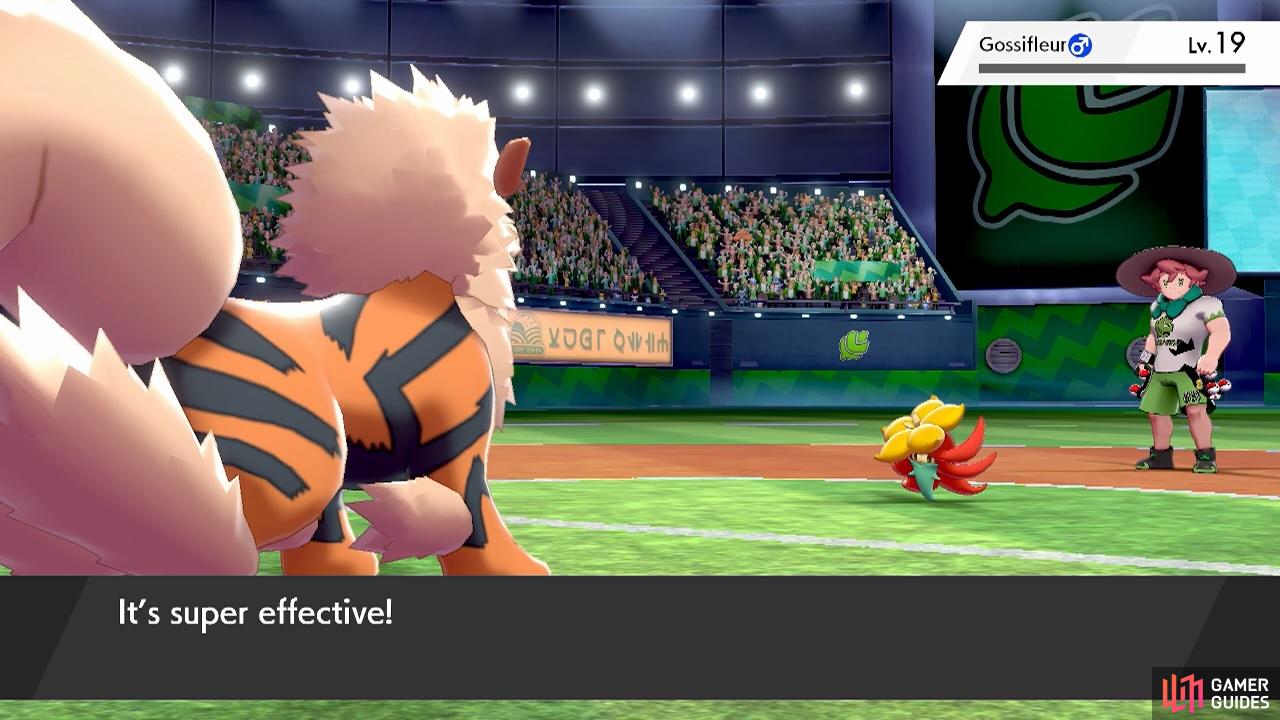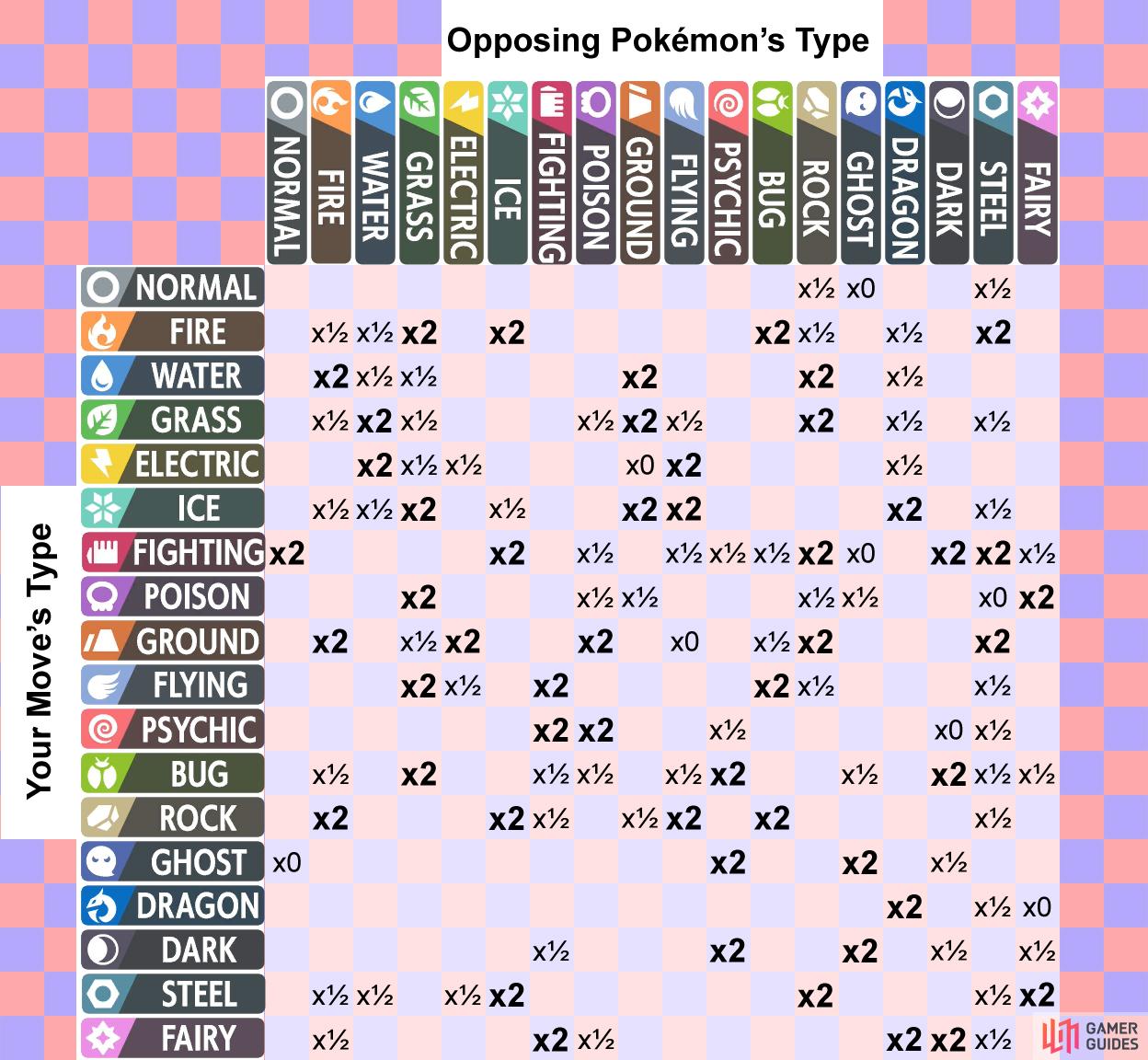Super-effective moves will make battles go twice as fast.
To graduate from a novice trainer, one of the important things you must learn is the Type-Match Up system. This has been around since the dawn of the series, so you should’ve had ample opportunity to get to grips with it. If this is your first Pokémon game though, or you need a refresher, listen up!
Types¶
Each Pokémon belongs to one or two Types, which you can see in various places, like the Pokémon menu or the Pokédex. There are 18 Types ranging from Normal, Fire, Water, Grass to Dark, Steel and Fairy. Generally speaking, a Pokémon’s Type(s) reflect their characteristics. So if a Pokémon has a flower sprouting from its head, it’s probably a Grass-type.
Similarly, every move that a Pokémon can use belongs to one of the same 18 Types. A move called “Water Gun” would be Water-type, for instance. Pokémon can learn moves that belong to their Type(s), but they may also learn moves of other Types.
Interactions¶
Just like real life, certain Types will do better or worse against other Types. For example, water can put out fire, so Water-type moves are strong against Fire-type Pokémon. Conversely, fire struggles to evaporate water so Fire-type moves are bad against Water-type Pokémon. Obviously, this is a huge simplification, but you get the idea.
If a move is strong against a particular Type, it will deal “super-effective” damage, which is double the normal amount. But if the move is weak, it will deal “not very effective” damage, which is half the normal amount. On the far extreme, it’s possible for moves to have “no effect”, resulting in zero damage. As you can hopefully see, it pays to know your match ups!
Our Handy Match-Up Chart¶
With 18 Types, that means there are 324 possible combinations. Which is quite a lot to learn! Thankfully, not every match up leads to an interesting result–in roughly half of all cases, the chosen Type is neutral against the targeted Type, resulting in the standard amount of damage. Still, that’s over a hundred to remember.
To assist you, we’ve compiled a useful chart that shows all the Type interactions, which you can refer to whenever you’re unsure. If you’re new to battling, we recommend learning the match ups for Fire, Water and Grass to begin with. Then see how you go from there. (Or you could always print out the match up chart or something!)
Dual-Type Pokémon¶
If your opponent has two Types, it’s slightly more complicated, but not that much. All you have to do is multiply the individual damage multipliers together.
For example, you’re fighting a  Centiskorch, which is a Fire and Bug-type. Normally, Ground deals 2x damage to Fire. However, it also deals 0.5x damage to Bug. So if you combine the numbers, it does 2 times 0.5 equals 1x damage. In other words, Ground is neutral against Centiskorch.
Centiskorch, which is a Fire and Bug-type. Normally, Ground deals 2x damage to Fire. However, it also deals 0.5x damage to Bug. So if you combine the numbers, it does 2 times 0.5 equals 1x damage. In other words, Ground is neutral against Centiskorch.
On the other hand, what if you used a Rock-type move against Centiskorch? Well, Rock deals 2x damage to Fire and it also deals 2x damage to Bug. So that means Centiskorch will take a massive 4x damage from Rock-type moves!
Other Factors¶
For most situations, the Type Match-Up chart is all you need. But keep in mind that it’s not completely full-proof. You also need to pay attention to other things like the Pokémon’s Abilities or held items.
A common thing to look out for is the Levitate Ability, which confers full immunity to Ground-type moves. If a Pokémon doesn’t have wings, but seems to be floating, it may have Levitate. Likewise, Pokémon with the Dry Skin Ability are immune to Water-type moves. This is less obvious than Levitate, but not as common.
On the flip side, Normal and Fighting moves are useless against Ghost-types. But if a Pokémon has the Scrappy Ability, they’ll be able to hit their spooky opponent with their Normal and Fighting type moves! The moves Foresight and Odour Sleuth have a similar effect as well.



 Sign up
Sign up
No Comments